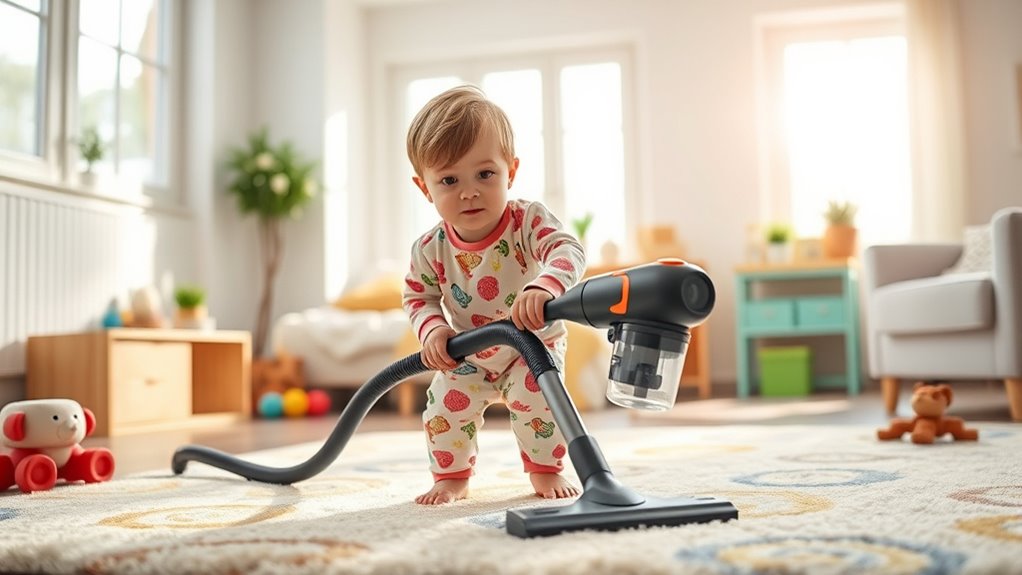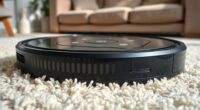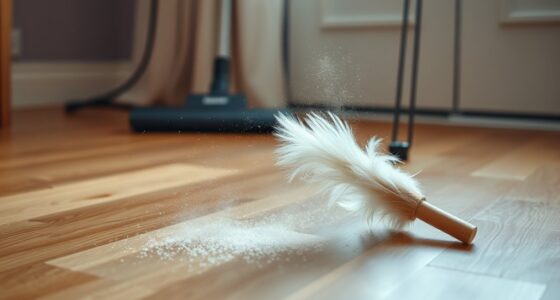To teach children to vacuum safely, start with age-appropriate tools and show them the proper technique, like maintaining a firm grip, vacuuming in straight lines, and avoiding furniture. Emphasize safety by supervising closely and unplugging the vacuum when not in use. Make it fun by playing music and praising their efforts. As they grow, introduce standard vacuums and responsible handling—stick with these tips to set a solid foundation for kid-proof cleaning skills.
Key Takeaways
- Use lightweight, age-appropriate vacuums with softer brushes and lower noise levels for younger children.
- Teach proper handling: firm grip, straight lines, gentle movements, and avoiding cord pulling.
- Emphasize safety: keep cords out of the way, unplug before adjustments, and supervise closely.
- Demonstrate correct technique first, then supervise as children practice, encouraging thorough coverage with overlaps.
- Make the activity fun by playing music, praising efforts, and assigning small sections for a sense of ownership.

Keeping your home clean when you have kids can feel like an ongoing battle, but with the right strategies, it’s manageable. One effective way to teach your children responsibility while keeping safety at the forefront is showing them how to vacuum correctly. The key is to prioritize safety precautions and use age-appropriate tools, guaranteeing they learn proper technique without risking injury or damage. When introducing your child to vacuuming, start by explaining safety precautions clearly. Let them know that the vacuum is a powerful tool, and they should never run it near their face or fingers. Make sure the cord is out of the way to prevent tripping, and teach them to unplug the vacuum before making adjustments or when they’re finished. Reinforcing these safety measures from the beginning helps build good habits and prevents accidents.
Next, choose age-appropriate tools to make the process easier and safer. For younger children, lightweight vacuums designed for kids are ideal. These often have a smaller size, softer brushes, and lower noise levels, which make them less intimidating and easier to handle. As your child gets older, you can transition to a standard vacuum, but still emphasize safety precautions. Show them how to hold the vacuum handle firmly, walk slowly, and avoid pulling on the cord. Demonstrate how to vacuum in straight lines, overlapping slightly, to ensure thorough cleaning without missing spots. Keep the vacuum level and avoid leaning too far forward to prevent strain. Additionally, teaching your child about the proper maintenance of the vacuum helps prolong its lifespan and ensures optimal performance.
Encourage your child to take ownership by making vacuuming a fun and engaging activity. Turn on some music, give them a small section of the room, and praise their efforts. Demonstrate the correct technique yourself first, then supervise as they try. Offer guidance on how to maneuver around furniture and reach corners, emphasizing gentle movements to avoid knocking over objects or scratching surfaces. Make sure they understand that vacuuming isn’t just about cleaning but also about taking care of the equipment and being safe.
Frequently Asked Questions
What Are the Best Age-Appropriate Vacuuming Tasks for Children?
You should start with simple vacuuming milestones for kids, usually around age three to five, when they can handle age-based chores safely. At this stage, they can help by pushing the vacuum or guiding the cord. As they grow, encourage more complex tasks, like vacuuming small areas or corners. This approach builds confidence and skill gradually, making vacuuming a fun and productive part of their chores.
How Can I Ensure My Child Vacuums Safely Around Fragile Items?
Think of your home as a delicate garden—you want to protect each bloom. To guarantee your child vacuums safely around fragile items, use childproof tips like setting boundaries, turning off the vacuum near precious objects, and guiding them with gentle supervision. Emphasize fragile item safety, teach your child to be cautious, and praise their careful efforts. This approach not only keeps your treasures safe but also builds their confidence and respect for your home.
Are There Child-Friendly Vacuum Models Designed for Beginners?
You’ll find many child-friendly vacuum models designed for beginners. Look for lightweight models with child-safe features like low suction and easy-to-use controls, ensuring your child can operate them safely. These vacuums are simple to maneuver, making the cleaning process fun and manageable for kids. Choosing a model with safety features helps prevent accidents, so your child can learn to vacuum confidently while staying protected.
How Do I Motivate Reluctant Children to Participate in Cleaning?
You might think kids dread cleaning, but you can change that with reward systems and fun challenges. Offer small incentives for participation and create friendly contests, like who vacuums the fastest or best. Make it a game rather than a chore, and they’ll feel motivated to join in. When cleaning feels like a fun activity, reluctant children naturally become more engaged and enthusiastic to help out around the house.
What Should I Do if My Child Mishandles the Vacuum or Causes Damage?
If your child mishandles the vacuum or causes damage, stay calm and address it calmly. Explain the importance of proper vacuum maintenance and how mishandling can lead to damage. Show them the correct way to handle the vacuum and supervise their use. Encourage gentle handling to prevent damage and teach responsibility. Reinforcing these lessons helps them develop good habits and reduces the chance of future mishaps.
Conclusion
By teaching your children to vacuum properly, you’re not only keeping your home cleaner but also helping them develop valuable skills. Did you know that kids who learn household chores early are 30% more likely to become responsible adults? So, involve them in cleaning routines and make it fun. With patience and guidance, you’ll turn chores into a bonding experience, and they’ll gain confidence and independence that lasts a lifetime.









